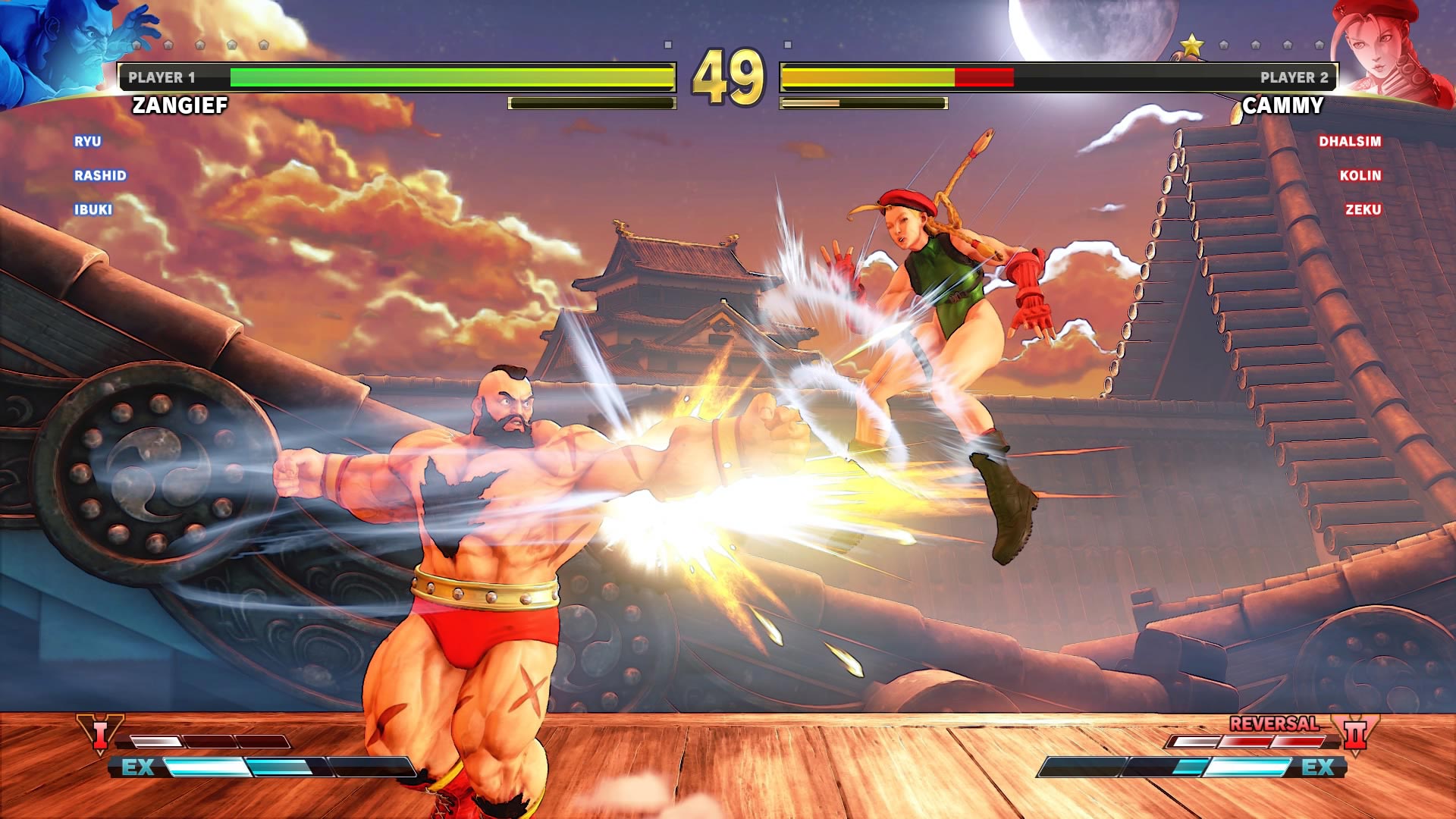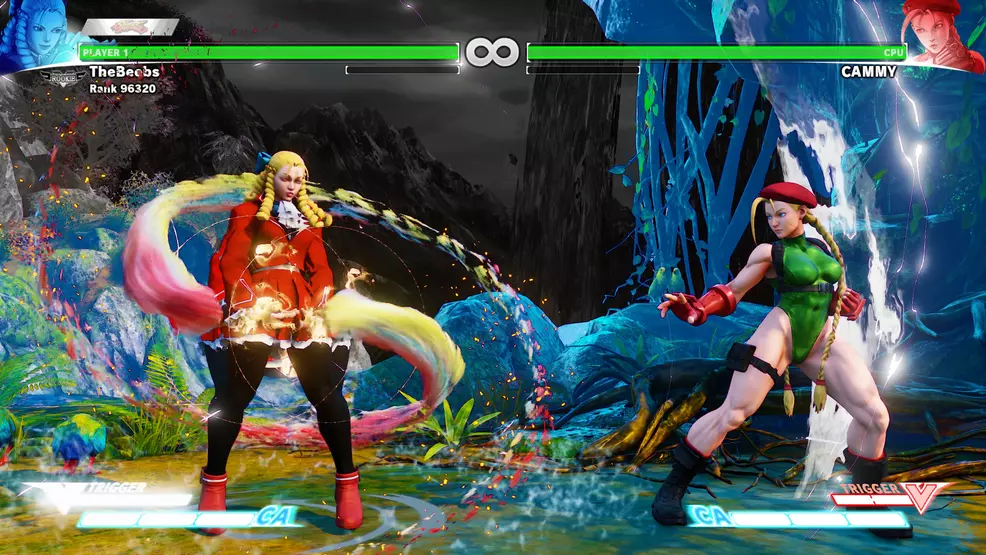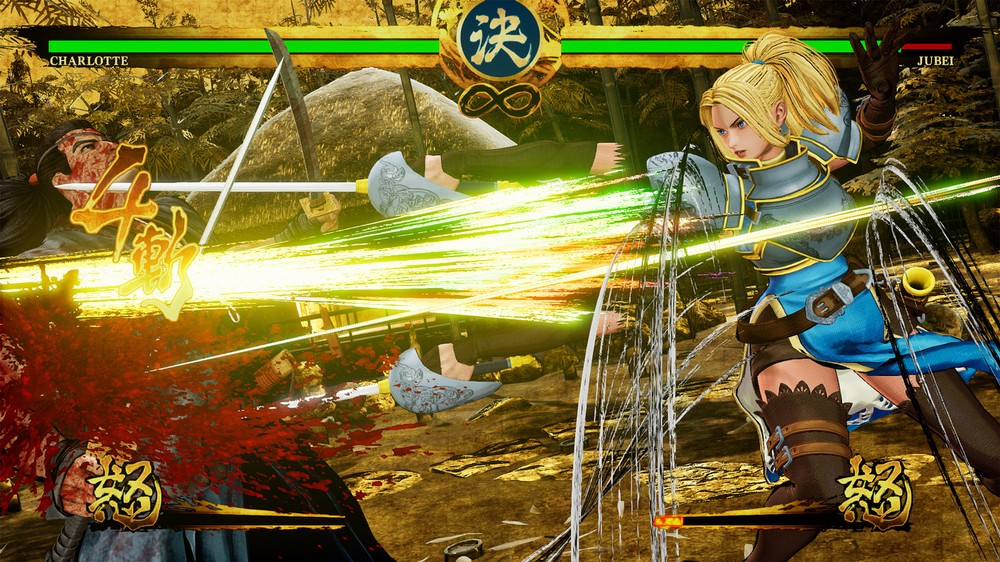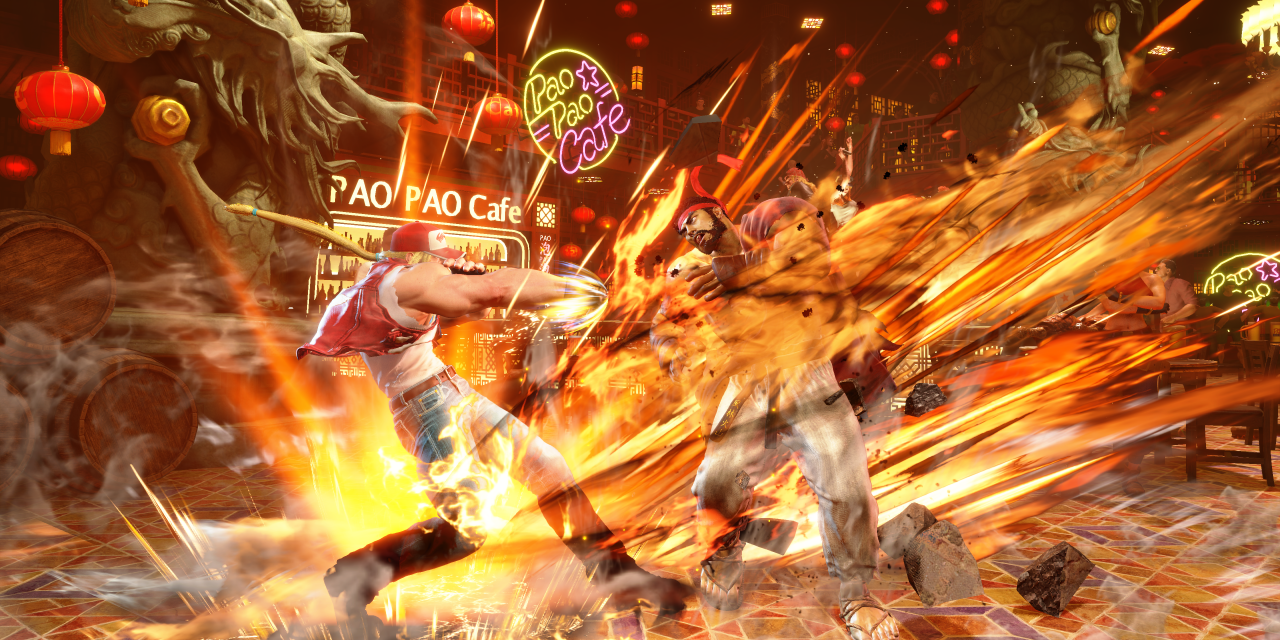This was the period where both company’s arcade releases
truly came to a near-close. That this
round starts in 2017 says it all. Since
2011, neither company made a single game for arcades that wasn’t an updated
version of a previous one. As I stated
last time, there were ports, mobile games and console games, but the previous
round set a precedent for both companies moving forward: now the console
versions of their fighting games would come first.
As if to rub it in Street Fighter 5’s face, SNK brought out
a new King of Fighters game with a massive 50 characters and a fully featured
arcade mode with substantial story content.
I heard stories about Street Fighter players jumping ship to KOF 14
because of how much of a rip-off Street Fighter 5 was. There’s footage of a pro Street Fighter
player telling Capcom representatives to their faces that he was going to go
play Guilty Gear instead of Street Fighter 5.
It was really REALLY bad. It’s
the stuff of legends.
That is not the version being judged though. Capcom continually added to Street Fighter 5
with overpriced DLC until they finally got a feature-rich and complete game
re-released as the Champion Edition, which is what came out in arcades. SNK had already released KOF 14 for arcades
with all its DLC included by that point, plus a little spin-off. With the release of SNK’s 2019 Samurai
Shodown game later, we’ll have reached the last arcade game released by either
company. We will finally see if Capcom
will cement their lead as the best arcade game manufacturer or if SNK will tie
the score.
The King of Fighters 14(SNK)
As much as The King of Fighters 13 is the greatest fighting
game ever made, it’s also one of the least newcomer friendly. There’s a lot inherent in the franchise’s
gameplay you’re expected to know as the game moves at a very fast pace and you
need to play 2 previous games to understand what’s happening in the first
place.
KOF 14 turns that around by being one of the MOST newcomer
friendly games in the franchise and a good jumping on point. Its combat pace is a little slower and more
manageable, comparable with the older games, and thanks to the events in the
previous game, knowledge of the previous games isn’t even entirely known by the
KOF mainstays, meaning newcomers are just as unaware as they are. 14 also introduces a huge number of new
characters mixed in with the old ones, giving newcomers characters to latch
onto without needing prior knowledge, but also providing returning fans with
less-seen characters like Tung Fu Rue and Oswald.
For some reason SNK decided to drop the perfect visual style
from the greatest fighting game ever made and instead went 3D, like Capcom, to
mixed success. The in-game character
models are the worst of it. They go into
the uncanny valley, don’t emote very well and have a slick, almost plastic
sheen to most of them that looks out of place after the darker color shadings
of previous games.
 |
| Shots like this are the advantage of 3D. |
Also just like Street Fighter 4, there’s full voice acting,
albeit only in Japanese regardless of the version. As a consequence of the better animation,
full voice acting and crap tons of characters, the pre-fight dialogue is only
for select characters, but to make up for that, certain characters fighting
each other will now trigger awesome new renditions of classic SNK tracks to
override the music already playing. Endings
are still done with artwork and text without voice, so SNK hasn’t dropped
their traditional presentation entirely.
It takes a little and gives a little.
The presentation of the franchise changed so much that
discussing the gameplay is almost an afterthought. The King of Fighters 14 plays like a classic
KOF game. As stated before, it’s not as
fast-paced as 13 is and is closer to KOF 98 or 99 in terms of game speed except
now it seems tweaked to facilitate combos.
The game isn’t as strict in how you need to time input commands, making
combos substantially easier to do, and blowback attacks now either bounce the
target off the wall or slam them against the wall to leave them open to a
follow-up attack. Despite the extra
opportunities to comboing, it’s back to the game being picky about what can
cancel into what and there’s no hyperdrive mode for more freedom.
The max mode that replaces hyperdrive mode is the worst part
of the game for me because EX moves can only be used while in it. The designers probably thought that max mode
gives players a time to go crazy like with hyperdrive mode, but what it really
does is make the player have to spend a super stock just for temporary permission
to do moves that are supposed to be used in the heat of the moment. It’s the exact same problem I had with crush
counters.
Sometimes there are wacky sound effects to go with it and
equally wacky are some of the character’s dialogue with each other. Since there are far fewer characters this
time, each one has a special victory quote for every other one and there’s a
special intro cutscene for the start of the game for every team combination,
excluding the characters that were DLC in the console version. All of this concludes with a trippy ending
followed by character-specific endings closing out the story for the two
winning characters, which are some of my favorite fighting game endings ever. The endings are a beautifully drawn series of
artwork full of funny character moments and references for longtime fans that tell
a story purely through expression and framing.
Playing the game to the end is a fun experience.
I know I said SNK Heroines was so easy that even a noob could
play it, but ironically it’s clearly targeted squarely at the SNK fans. New players coming off of 14 will have some
fun with the new characters introduced in that game, but they’ll be in the dark
as to who Miss X is or what’s going on in Yuri and Terry’s endings. As the game’s target audience, I love
it. It’s a game to play when I need a
break and a laugh from all the serious fighting games.
It took away the two ultra attacks and instead made the
super attack the ultimate hard-hitting attack, now with a smaller super meter
that fills faster. Instead of choosing
between ultra attacks, the choices made before a match are more important to
the moment-to-moment gameplay, with each character now getting two choices for
both a V-drive, a special move activated at any time, and V-trigger, a more
powerful move that requires a meter to be filled. What the V-drive and V-triggers do can vary
wildly, with some V-triggers effectively being another super attack and others
being a temporary powered up state. It
can be satisfying when you can turn the tables by using a good temporary boost
effectively, but I’d frankly rather have kept the ultra attacks.
The V-skills and ease of forming combos makes Street Fighter
5 lean closer to the feel of an Arc System Works fighter like Guilty Gear or
Blazblue. Successful strikes cause more
recoil than usual, ESPECIALLY on a counter hit, allowing for plenty of time to
follow-up with another attack and that’s combined with the much more lenient
timing for connecting attacks with each other.
This leads to Street Fighter 5 rewarding aggressive play a lot more, a
big departure from the feeling of landing one good gratifying hit, as I’ve
described in previous games.
In what is also comparable to an Arcsys game, V-skills can be
downright gimmicky and ill-fitting of martial arts action, like Rainbow Mika
powering up attacks by trash talking or Birdie dropping trash for the opponent
to trip over. That’s not necessarily a
bad thing because that means all the characters have more variety and slightly
bigger move sets, but they can drift away from the straightforward street
fighting the series is known for.
It’s not enough that it’s the best-looking Samurai Shodown
game. It also has the best
gameplay. The only thing it takes away
from Samurai Shodown 6 is that attacks don’t do quite as much damage as they
used to, but they still do more than in that game. Unlike 6, the weight of the blade is back and
the pacing of battle is much more in line with Samurai Shodown 2. There is a satisfying, brief stop when you
land a clean heavy slash, characters can be bisected if you finish them off
with one, blood flies everywhere and some of it can even get on the characters
themselves.
The violence never quite reaches the gore fest that was the
overkill moves in Samurai Shodown 5 Special, as those have been replaced by new
super moves. These moves are separate
from the disarming moves and much harder to successfully land. They have short range, more startup, leave
the user wide open when they miss and the game briefly pauses to warn the other
player it’s being used. Either the user
has to read their opponent super hard or the opponent has to be a reckless
idiot to successfully pull one off. When
it lands though it will usually take off 3 quarters off the health of the
target. It takes the concept of landing
the perfect hit to a whole new level and that makes it all the more gratifying
when it works.
All this top-tier gameplay and presentation is housed in a
sizable character selection. All the
essential Samurai Shodown characters are present and accounted for alongside
some of the less-seen ones like Earthquake, Wan Fu and Shiki. The handful of new characters are some of my
favorites in the franchise, even if this is the only game they’re in, and all
the characters get their own story intros, rival battles, character-specific
victory dialogue and endings.
Since the story is set between 5 and the first game, all the
returning characters get lead-ins to their first appearances, with several
call-forwards and developments. There’s
an explanation for why Shiki isn’t seen again until Samurai Shodown 64, why Wan
Fu was using a Schimitar in the first Samurai Shodown instead of his pillar and
Basara’s story at least plants the seeds for his vendetta against Zankuro in
Samurai Shodown 3.
With top-notch presentation, story, characters and gameplay,
this might be one of the best games ever released to arcades, let alone the
best Samurai Shodown game. This is game
of the year round hands-down.
The Winner
After Samurai Shodown 2019 I think it should be obvious that
Street Fighter 5 didn’t carry Capcom for this round. It was better than SNK Heroines by having
deeper combat and more characters, but even then SNK Heroines had a fun story
to it when Street Fighter 5 had none.
The King of Fighters 14 also had a fun story, but even if I were to put
Street Fighter 5 on roughly equal terms with it in terms of gameplay, Samurai
Shodown 2019 was better than all of them this year, handing the win to SNK.
The Final Winner
After over half a year of writing this series, playing over
100 different arcade games, the final score has been reached. I shall now go over the winner of each
year/round one more time.
1986: SNK
1987: SNK
1988: Capcom
1989: Capcom
1990: Capcom
1991: Capcom
1992: SNK
1993: Capcom (originally SNK, but later retroactively given to Capcom)
1994: Capcom
1995: Capcom
1996: SNK
1997: SNK
1998: Capcom
1999: SNK
2000: SNK
2001: Capcom
2002-2004: SNK
2005-2008: SNK
2009-2010: Capcom
2012-2014: SNK
2017-2019: SNK
and again
and again.
War... War never changes.











No comments:
Post a Comment